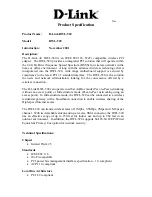
OPTIMOD-PC
OPERATION
3-39
transition between linear operation and flat topping occurs abruptly as the clipper’s
input level is changed. “10” is the softest knee, where the transition starts 6 dB be-
low
B
ASS
C
LIP
T
HRESH
setting and occurs gradually. The factory default setting is
“7.6.”
Figure 3-3: Bass Clipper Input/Output Transfer Curves as Bass Clip Shape Control is
Varied from 0.0 (Hard) to 10.0 (Soft)
Final Limit Drive
control adjusts the level of the audio driving the low-IM look-
ahead limiter that OPTIMOD-PC uses to control fast peaks, thereby adjusting the
peak-to-average ratio of the processed audio. The
F
INAL
L
IMIT
D
RIVE
control primarily
determines the loudness/distortion trade-off.
Turning up the
F
INAL
L
IMIT
D
RIVE
control drives the look-ahead limiter harder, reduc-
ing the peak-to-average ratio, and increasing the loudness on the air. When the
amount of limiting is increased, the audible intermodulation distortion caused by
limiting increases, even though special algorithms minimize the increase compared
to less sophisticated designs. Lower settings reduce loudness, of course, but result in
Distortion Control Adjustments
Name Range
Bass Clip Threshold
–6.0 … +6.00, Off
Speech Bass Clip Threshold
–6.0 … +6.00, Off
Bass Clip Shape
0.0 … 10.0
Final Limit Drive
–10.0 … +12.0
Table 3-7: Distortion Control Adjustments
















































